The most famous John Clayton, no doubt, is the creation of Edgar Rice Burroughs, better known as Tarzan of the Apes. The ape-man's father was also a John Clayton, as were practically all the eldest sons of the Greystoke lineage. Although Burroughs' figure may be the most famous, he is not the only author to use the name John Clayton in his writings.
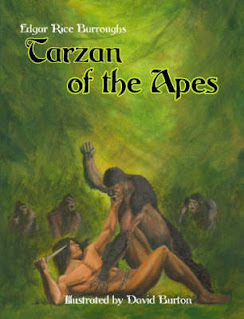 |
| Tarzan Of The Apes |
In Three Months In The Jungle, by Sebastian Moran, published in 1884, a person named John Clayton, whose near-fatal mauling by a tiger, is described in chapter 12. Many Edgar Rice Burroughs researchers believe this John Clayton to actually be Tarzan's father. If one accepts Tarzan Of The Apes provided date, May 1888, as John and Alice's sailing date, it could be possible that it was Tarzan's father.
 |
| Tarzan Of The Apes |
The only problem with accepting, 1888 as the Greystoke's sailing date, is that Korak can not be Tarzan's flesh and blood-born son. If one believes the Fuwalda set sail in May 1888, one must also believe that Korak was adopted in some form, or the events in The Son Of Tarzan did not occur. There is one other option available, of course. Believe Tarzan and his family are time travelers or dimension hoppers. If that is your belief do not bother reading chronology articles. You don't need them.
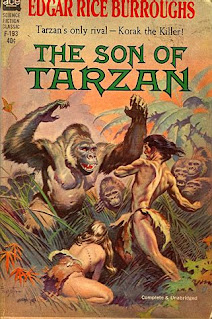 |
| Frank Frazetta |
There are many Edgar Rice Burroughs chronologists who believe that Tarzan is Korak's paternal father as told in The Beasts Of Tarzan, The Son Of Tarzan, The Eternal Lover, Tarzan The Untamed, Tarzan The Terrible, and Tarzan And The Golden Lion. They believe the Fuwalda set sail much sooner than the date provided in Tarzan Of The Apes. Using this approach nicknamed "the pushback theory" the most accepted date is 1872. If one accepts this theory, the John Clayton mentioned in Three Months In The Jungle could not possibly be Tarzan's father. If that is the case then who is he? To shed a little more light on this question, let's go one step further.
 |
| Frank Frazetta |
Besides Burroughs' John Clayton in Tarzan Of The Apes, and the John Clayton mauled by a tiger in Three Months In The Jungle, there is yet another. Sir Arthur Conan Doyle's cab driver in The Hound Of Baskervilles. During that intriguing investigation of October 1889, Sherlock Holmes questions a rough-looking fellow, who had been driving a cab for seven years. His address was; 3 Turpey Street, the Borough, and his cab was out of Shipley's Yard, near Waterloo Station. The driver turns out to be no part of the investigation, and once dismissed never plays another part in the story.
 |
| The Hound Of The Baskervilles |
If Doyle's John Clayton has been driving a cab from 1882 through October 1889, it is obvious that he is neither Tarzan nor his father. As noted earlier, Sebastian Moran's Three Months In The Jungle was published in 1884. If you subtract the time that it would take for those events to occur, the author finding out the events, the adventures to be penned, then to be published, it is conceivable that John Clayton who was mauled by the tiger could possibly be the cab driver of Doyle's story. If this John Clayton is not Tarzan, nor his father. Who is he?
 |
| Tavener Scholar |
We know that it is a Greystoke family tradition for the firstborn to be named John. Burroughs plainly states in Tarzan Of The Apes that Tarzan's name is John, and the ape man's father's name was John. Although Korak is called Jack and his son is called Jackie, their name is also John. One can use Burroughs' own son, John Coleman, as circumstantial evidence, for he was called Jack. Also, John Carter's great-nephew called him Uncle Jack.
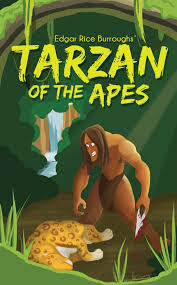 |
| Tarzan Of The Apes |
Using these four generations as proof, one would automatically presume that Tarzan's grandfather was also a John. This is not the case, however. Burroughs clearly indicates that Tarzan's grandfather was not a John Clayton. When Paul D'Arnot was reading Lord Greystoke's diary to Tarzan we find that Tarzan is the second John Clayton. "Somehow, even against all reason, I seem to see him a grown man, taking his father's place in the world - the second John Clayton - and bringing added honors to the house of Greystoke." ERB-Tarzan Of The Apes, chapter 25.
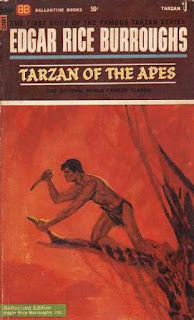 |
| Tarzan Of The Apes |
If Tarzan's grandfather was not a John Clayton, then what was his name? This is a very touchy subject because it can not be proved. Using speculation only, Tarzan's great-grandfather's first son was born under illegitimate circumstances. The birth was kept secret, but the child was given the name John Clayton anyway. When great-grandfather Clayton's second son, Tarzan's grandfather, was born he was the legitimate first Greystoke child, but he was not the firstborn.
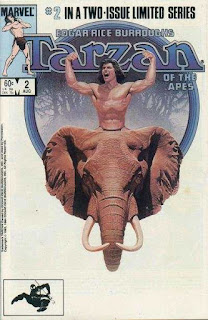 |
| Tarzan Of The Apes |
Thus, he was named something besides John. When Grandfather Clayton's first son, Tarzan's father, was born he was named John Clayton. This was done to continue the Greystoke tradition of naming the firstborn son John.
 |
| Burne Hogarth |
Out of mockery for the Greystoke's John Clayton, the illegitimate older half-brother to Tarzan's grandfather named his firstborn son John Clayton also. This is the other John Clayton mentioned in Three Months In The Jungle and The Hound Of Baskervilles.
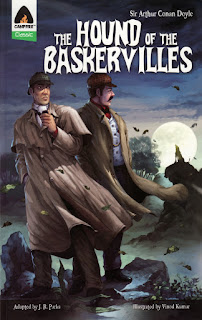 |
| The Hound Of The Baskervilles |
ABOUT THE AUTHOR
James Michael Moody is a lifelong fan and collector of Edger Rice Burroughs. Over the past forty-five years, Moody has contributed over two hundred articles to various ERB-related fanzines. He also manages an unauthorized Tarzan blog titled Greystoke Chronologist: James Michael Moody. There, the researcher chronologies the Tarzan books starting in May 1872 (known as the pushback theory) instead of the more accepted date, May 1888.
James Michael Moody also authorizes the action-packed Sci-Fi fantasy adventure null. Pioneers On Unium, published December 31null, 2019, Exiled On Unium, published August 25, 2022, and Swordsman On Unium, published on July 15, 2024.
No comments:
Post a Comment